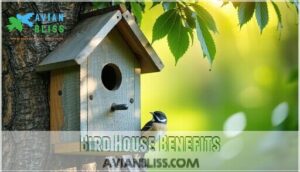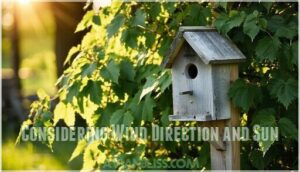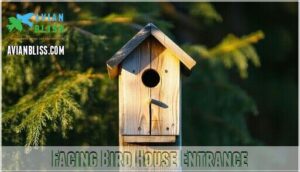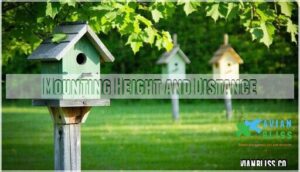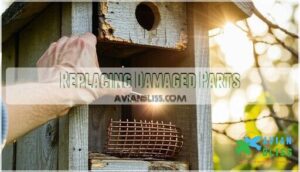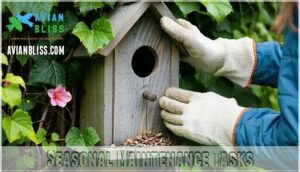This site is supported by our readers. We may earn a commission, at no cost to you, if you purchase through links.
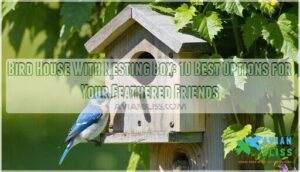
It helps protect them from predators and harsh weather while giving them a cozy home.
Bluebirds, chickadees, and wrens love well-built nesting boxes, especially those made from natural wood like cedar.
To keep birds happy, place the house at the right height and keep it away from busy areas.
Clean it out after nesting season to keep the space healthy and make a big difference for local birds—keep reading to learn how to pick the perfect one!
Table Of Contents
- Key Takeaways
- Bird House Benefits
- Top 10 Bird Houses
- 1. Predator Guard Bird House Outdoor
- 2. Cedar Bird House Two Pack
- 3. Cedar Bluebird House Wild Wings
- 4. Waterproof Vinyl Bluebird House Nesting Box
- 5. Cedar Bluebird House Two Pack
- 6. Wooden Dove Nesting Box Outdoor
- 7. Parakeet Nesting Box Bird House
- 8. Navaris Small Pine Wood Birdhouse
- 9. Cedar Bluebird House Nature’s Way
- 10. Hummingbird House Outdoor Hanging Nesting Box
- Bird Species Preferences
- Installing Bird Houses
- Maintaining Bird Houses
- Frequently Asked Questions (FAQs)
- What is the difference between a birdhouse and a nesting box?
- Are birdhouses actually good for birds?
- What is the best birdhouse to attract birds?
- Where not to put a bird house?
- What is the difference between a nesting box and a birdhouse?
- What kind of bird house do birds like the best?
- What color birdhouse attracts birds the most?
- Which way do you face a bird box?
- How to design a predator-proof birdhouse?
- Which materials are best for birdhouses?
- Conclusion
Key Takeaways
- You’re helping birds thrive by giving them a safe place to rest and raise their young.
- Match the birdhouse design to species’ needs with proper entry holes, durable materials like cedar, and predator protection.
- Place it at the right height, facing east or southeast, away from busy areas to keep birds comfortable and safe.
- Clean and maintain the birdhouse regularly to prevent pests and ensure a healthy environment for nesting birds.
Bird House Benefits
You’ll help birds survive habitat loss by adding a nesting box to your yard.
Birds need safe places to raise their young, and your birdhouse provides this essential shelter when natural nesting spots are scarce.
Birdhouses offer a lifeline for birds, creating safe, cozy havens when natural nesting spots disappear.
Importance of Nesting Boxes
Many bird species struggle to find suitable homes in today’s changing landscapes.
Nesting boxes provide essential habitat supplementation for cavity nesters who can’t find natural holes for their nests. They offer safe bird shelter during breeding season, which directly supports declining populations.
You’ll also enjoy incredible viewing opportunities as birds raise their young. A simple bird house creates a win-win situation – birds get homes and you get front-row seats to nature’s show.
Supporting Bird Populations
Beyond providing shelter, nesting boxes directly boost bird populations in your community.
Nesting boxes transform your yard into a haven, helping bird populations thrive while offering a front-row seat to nature’s wonders.
When you install a bird house, you’re lending a helping hand to local birds who need safe spots to raise their young.
A well-placed nesting box supports bird populations by:
- Increasing nesting success rates by up to 70%
- Creating safe spaces for chicks away from predators
- Encouraging multiple broods per season
- Connecting fragmented bird communities across urban areas
Addressing Habitat Loss
Habitat loss hits birds hard.
As forests shrink and wetlands vanish, cavity-nesting birds lose their homes.
Your backyard can become a refuge! By adding nesting boxes, you’re fixing a broken link in nature.
Urban nesting opportunities help birds adapt to city life, while rural decline and forest fragmentation are offset through these simple homes.
It’s bird conservation you can do right now—one box at a time.
Protecting habitats helps with support for biodiversity through support for biodiversity, which is a crucial aspect of nature preservation.
Top 10 Bird Houses
You’ll find the perfect home for your backyard birds in our top 10 nest box selection. These birdhouses offer safe shelter with proper dimensions for various species from bluebirds to hummingbirds.
1. Predator Guard Bird House Outdoor
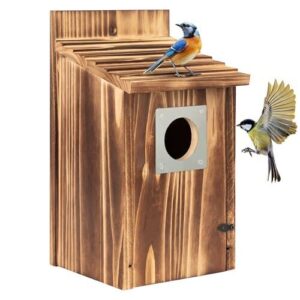
You’ll keep your feathered friends safe with the Predator Guard Bird House.
Made from solid pine wood with a carbonized surface, this house stands 9.85 inches tall.
The stainless steel guard stops squirrels and larger birds from bothering nesting birds.
It’s easy to clean thanks to the front door design.
Inside grooves help baby birds climb out when ready.
The house fits bluebirds, wrens, chickadees, and tree swallows.
At just 1.79 pounds, you can mount it on trees or fences with the included hardware.
Customers love its sturdy build and weather resistance, making it a great choice for your backyard, providing a safe haven for birds with its solid pine wood construction.
Best For: Backyard bird enthusiasts who want a sturdy, weather-resistant birdhouse that attracts and protects species like bluebirds, wrens, chickadees, and tree swallows.
Pros:
- Solid pine wood construction with stainless steel guard for added durability.
- Front door design allows easy cleaning and maintenance.
- Lightweight and simple to mount on trees or fences using included hardware.
Cons:
- Made from pine wood instead of more durable cedar.
- Some customers experienced minor assembly issues.
- Manufactured in China, which may not appeal to all buyers.
2. Cedar Bird House Two Pack
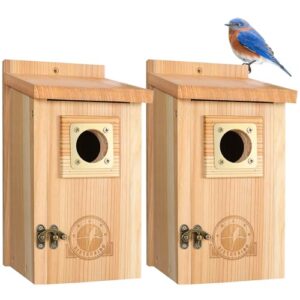
Every bird lover needs this Cedar Bird House Two Pack in their yard.
Made from solid, untreated cedar wood, these houses feature a perfect 1.5" entrance hole that attracts bluebirds, wrens, and chickadees while keeping starlings out.
The copper predator guard adds extra protection for your feathered visitors.
You’ll appreciate the easy-clean design—just open the front door after the babies leave.
Interior grooves help fledglings climb out when they’re ready to fly.
The rough cedar surface gives birds a good foothold and stands up to weather season after season.
Best For: Bird enthusiasts who want a durable, predator-safe birdhouse for attracting bluebirds, chickadees, and wrens.
Pros:
- Made of untreated cedar for weather resistance and durability.
- Copper predator guard ensures safety for young birds.
- Easy-clean front door for post-nesting maintenance.
Cons:
- Not suitable for European starlings or larger birds.
- Requires assembly with a screwdriver.
- Higher initial cost compared to some alternatives.
3. Cedar Bluebird House Wild Wings
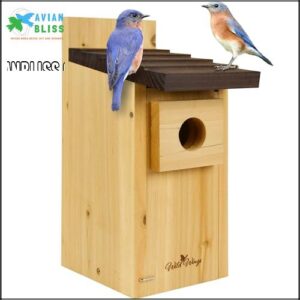
Many bird lovers choose the Cedar Bluebird House Wild Wings for its premium materials and thoughtful design.
It’s made with naturally rot-resistant cedar and stainless steel hardware that lasts for years.
You’ll appreciate the easy-open front panel that lets you check on nesting birds and clean without disturbing them.
The copper top roof and laser-etched bluebird add a nice touch to your yard.
This house attracts bluebirds, tree swallows, chickadees, nuthatches, titmice, and wrens.
Its innovative design combines ease-of-use with superior quality for happy birds.
Best For: Homeowners and bird enthusiasts looking to attract bluebirds and other small songbirds with a durable, easy-to-clean birdhouse.
Pros:
- Made from rot-resistant cedar and stainless steel hardware for long-lasting durability.
- Easy-open front panel allows simple cleaning and monitoring of nesting birds.
- Attracts a variety of small birds, including bluebirds and tree swallows.
Cons:
- Occasionally arrives with shipping damage.
- Model discrepancies in some deals may lead to confusion.
- Copper top roof may require maintenance to retain its appearance over time.
4. Waterproof Vinyl Bluebird House Nesting Box
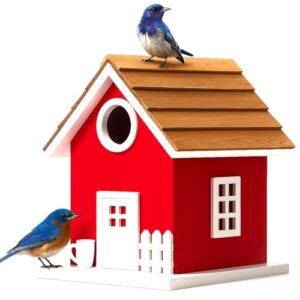
Looking to keep bluebirds happy year-round? This waterproof vinyl bluebird house stands up to any weather.
Built from PVC/vinyl with a copper roof, it won’t rot, crack, or fade. The 1.5-inch entry hole features a raised copper predator guard, keeping birds safe.
At 24 inches tall, this house is easy to mount on fences or poles about 5 feet off the ground. Face the entrance away from prevailing winds.
Proper ventilation is also essential for a comfortable nesting environment. The top opens for easy cleaning, and the drop-down floor makes maintenance simple.
This house will last a lifetime.
Best For: Dedicated bird enthusiasts seeking a durable, long-lasting birdhouse that prioritizes safety and easy maintenance.
Pros:
- Waterproof PVC/vinyl construction resists weather damage.
- Includes raised copper predator guard for bird safety.
- Top opens and floor drops for effortless cleaning.
Cons:
- Requires careful placement to avoid strong winds.
- May need additional predator deterrents for optimal protection.
- Taller design might not fit compact garden spaces.
5. Cedar Bluebird House Two Pack
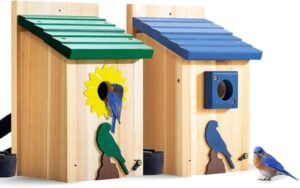
The Cedar Bluebird House Two Pack is a top pick for bird lovers who want safe, durable homes for bluebirds.
Made of thick white cedar, it’s built to last through weather and predators. The front opens easily, letting you clean out old nests fast.
With a 1.5-inch entrance hole and proper ventilation, it’s perfect for bluebirds, chickadees, and wrens. It even has a predator guard to protect from raccoons.
This affordable option is easy to install and makes your backyard lively!
Best For: Bird enthusiasts looking for a durable, affordable, and easy-to-maintain nesting solution for bluebirds and similar species.
Pros:
- Sturdy cedar construction with predator guard for added safety.
- Easy-to-clean front opening and proper ventilation.
- Affordable pricing with mounting accessories included.
Cons:
- Mixed feedback about missing or insufficient screws in some packages.
- Assembly required with optional sealant for best water protection.
- Currently out of stock at some retailers, requiring a waiting list.
6. Wooden Dove Nesting Box Outdoor
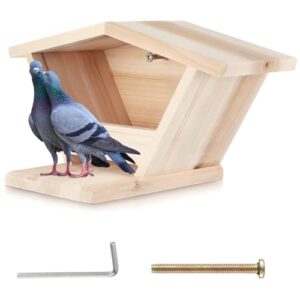
The Wooden Dove Nesting Box Outdoor is a cozy spot for smaller birds but not ideal for doves due to its size.
Its durable, weather-resistant wood protects against the elements, while the triangular opening adds charm to your garden.
Pre-drilled holes make it easy to install, and the design encourages natural nesting behaviors.
Though some reviewers noted minor quality issues, it’s perfect for small species and bird lovers, making it a great choice for bird lovers.
Consider adding nesting material for comfort and placing it securely for safety.
Best For: Small bird species and bird enthusiasts looking for a charming, weather-resistant nesting option for their garden.
Pros:
- Durable, weather-resistant wood for year-round use.
- Charming triangular opening that enhances garden aesthetics.
- Easy to install with pre-drilled holes.
Cons:
- Too small for doves despite being marketed for them.
- Reported quality control issues, including damaged products during delivery.
- Requires additional nesting material for optimal comfort.
7. Parakeet Nesting Box Bird House
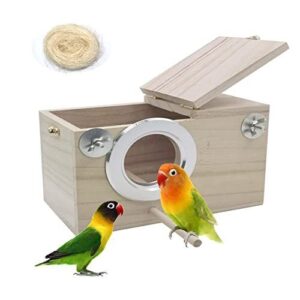
A parakeet nesting box is perfect for small birds like budgies and cockatiels.
Made from sturdy wood, it offers a simple yet effective design. The curved top keeps things stable, while the front hole and perch provide easy access.
Install it inside or outside your bird’s cage for flexibility. A soft, dry nesting material helps guarantee safety for eggs and chicks.
With enough space and comfort, it encourages natural breeding habits. It’s a cozy and secure home just for them.
Best For: Small to medium-sized bird species like budgies, parakeets, and cockatiels that need a safe and comfortable nesting environment.
Pros:
- Made from eco-friendly, sturdy wood for durability.
- Encourages natural breeding and nesting behaviors.
- Easy to clean with a top-hinged lid design.
Cons:
- Limited size options may not fit larger bird species.
- Requires separate soft nesting material for proper use.
- Some assembly or mounting may be needed for proper installation.
8. Navaris Small Pine Wood Birdhouse

The Navaris Small Pine Wood Birdhouse is a cozy spot for small birds like hummingbirds and robins.
Made from real pine wood, it’s lightweight and sturdy, with a 30mm entrance hole perfect for smaller species.
The compact design blends into nature and works great in yards or gardens.
It’s ready to hang with a pre-drilled hole, making setup a breeze, and is perfect for bird-watching during nesting season, although some users suggest sanding rough wood areas before use to make it even more sturdy.
Best For: Bird lovers looking for a natural, compact nesting box ideal for small species like hummingbirds, robins, and finches.
Pros:
- Lightweight and easy to hang with pre-drilled hole.
- Compact design blends well with outdoor environments.
- Sturdy pine wood construction provides a cozy nesting spot.
Cons:
- Rough wood may require sanding for smoother surfaces.
- Not weatherproof, potentially deteriorating in rain or high humidity.
- Some users find the price high for the quality.
9. Cedar Bluebird House Nature’s Way

Nature’s Way Cedar Bluebird House is perfect for bluebird lovers. It’s crafted with durable cedar and rust-free hardware, ensuring it lasts for years.
The 1.5-inch entry hole keeps predators out, while air vents and fledgling kerfs create a safe, airy space for birds. Cleaning is simple with the hinged door design.
Install it on a pole or fence post in a sunny spot, and you’ll attract birds easily. Many users report seeing bluebirds nest just days after setup.
Best For: Bird enthusiasts looking to attract bluebirds to their yard with a durable and easy-to-maintain birdhouse.
Pros:
- Made from premium cedar and stainless steel for long-lasting durability.
- Features like air vents, predator guard, and fledgling kerfs ensure safety and comfort for birds.
- Easy to install and clean, with a hinged clean-out door.
Cons:
- May require additional customization for hanging options.
- Some packaging issues reported during shipping.
- Wire mesh floor might need extra preparation to ensure bird safety.
10. Hummingbird House Outdoor Hanging Nesting Box
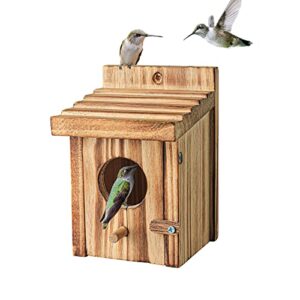
The hummingbird house is a charming addition to your garden, but it’s more decorative than functional.
Hummingbirds prefer building open, naturally crafted nests using organic materials, while the design features like a perch and wooden structure appeal to small birds.
It’s unlikely to attract actual hummingbirds, instead, focus on planting nectar-rich flowers or providing nesting materials nearby.
This house works well for enhancing outdoor décor or delighting bird lovers as a gift, just don’t count on it for hosting hummingbirds.
Best For: Garden enthusiasts or gift shoppers looking for a decorative birdhouse for small songbirds or outdoor décor.
Pros:
- Made from natural, durable solid wood.
- Lightweight and easy to hang or set up.
- Aesthetic design enhances garden decor.
Cons:
- Not suitable for actual hummingbird nesting.
- May require modifications for added safety.
- Entrance size potentially too large for some bird species.
Bird Species Preferences
Each bird species has unique nesting needs to feel safe and thrive. Matching the right birdhouse to the species guarantees they’ll settle in and raise their young properly.
Bluebirds and Nesting Requirements
Bluebirds need nesting boxes with a tight design and an entry hole diameter of 1.5 inches.
The bluebird box size should provide about 4×4 inches of interior space.
Use soft nesting material like dry grass.
Place each bluebird house at least 60 feet from others.
Add predator protection to keep birds safe, adapting for regional variations.
Robins and Cardinals Nesting Sites
Robins and cardinals prefer open nesting in natural spaces, not birdhouses.
Cardinals choose dense shrubs and trees for their habitat, creating nests with twigs and grass. Robins use versatile sites like branches or windowsills, adding mud for strength.
Proper site selection guarantees safety and comfort. While nesting boxes don’t suit them, enhancing bird habitats supports their behavior and nesting needs.
Chickadees and Wrens Entrance Holes
Chickadees and wrens need birdhouses with specific designs.
For chickadees, a 1 1/8-inch hole size works best, while wrens prefer a 1-inch hole.
Proper hole placement, about six inches above the floor, improves predator protection.
Choose durable materials like cedar or recycled plastic.
Each species variation benefits from thoughtful birdhouse sizes and entrance orientation to meet their nesting needs.
Purple Martins Colonial Nesting
Purple Martins thrive with the right birdhouse designs, preferring colonies of multiple units.
To attract them:
- Use sturdy housing materials like metal or plastic to prevent wear.
- Confirm proper gourd placement and height for predator control.
- Position the purple martin house near water to aid martin migration.
Smart birdhouse placement keeps these birds coming back year after year, which is crucial for their migration. Ideal placement includes open, sunny areas to create an attractive environment for martin colonies.
Installing Bird Houses
When installing a bird house, place it where birds feel safe and protected. Make sure the height, entrance direction, and mounting method match the bird species you want to attract.
Considering Wind Direction and Sun
When placing your birdhouse, think about prevailing winds and sun exposure.
Shield it from harsh winds to protect nesting birds. Too much sun can overheat the box, so aim for balanced thermal comfort.
Ideal placement also affects birdhouse sun exposure. Consider your regional climate and microclimates nearby.
A good birdhouse design placed in the right spot helps birds thrive while keeping their nest safe and cozy.
Facing Bird House Entrance
The direction your birdhouse faces matters for species and weather. Aim for entrances to face east or southeast. This reduces harsh weather exposure and increases sunlight.
Here’s how to guarantee proper birdhouse placement tips:
- Avoid west-facing entrances.
- Align for species orientation.
- Use predator protection measures nearby.
- Pick an ideal angle away from winds.
- Guarantee entrance direction suits local birds.
Consider also entrance direction products to aid in proper installation with proper birdhouse placement.
Mounting Height and Distance
When choosing the right spot for your birdhouse, height matters.
Mounting it 5-12 feet high works for most birds and helps with predator avoidance.
Follow spacing guidelines: keep birdhouses 300 feet apart to reduce species competition.
Habitat considerations like nearby trees or open space improve success.
Consider optimal height products for your specific bird species.
Proper birdhouse installation guarantees safety and comfort for nesting birds.
Choosing Mounting Method
Every birdhouse mounting method has its perks.
Pole mounting offers strong support and security, while tree mounting uses natural placement.
Hanging options work for lightweight birdhouses, but check stability.
Ground placement isn’t ideal due to predators.
Always use mounting hardware designed for birdhouse installation to guarantee safety and functionality for your feathered friends.
Maintaining Bird Houses
Keeping bird houses clean and intact helps birds stay healthy and safe. Regular maintenance stops pests, predators, and damage from causing problems.
Cleaning and Disinfecting
Keeping birdhouses clean is essential. After the nesting season, remove old nests and debris. Use a mild bleach solution (1:20 ratio) to disinfect. Scrub well and let it air dry.
- Follow these steps:
- Clear out nesting material.
- Use disinfectant solutions for pests.
- Clean annually or after nesting.
- Wear gloves for safety precautions.
Birdhouse maintenance supports healthy bird populations! To encourage birdhouse reuse, it’s best to perform annual birdhouse cleaning.
Replacing Damaged Parts
Check your birdhouse for damage after cleaning.
Replace rotted wood to keep it sturdy.
Fix or swap predator guards if they’re loose or broken.
Patch small holes, but replace larger sections if needed.
Don’t forget hardware replacement—you want screws and hinges secure.
For roof replacement, use durable materials to keep birds dry.
Regular birdhouse repair keeps it safe and cozy.
Seasonal Maintenance Tasks
Seasonal birdhouse care keeps birds safe and cozy.
Focus on these tasks:
- Spring Cleaning: Remove old nests and sanitize with a mild bleach solution (1:9).
- Predator Control: Add guards or baffles.
- Repair Assessment: Fix cracks or damage in wood or plastic.
- Winter Protection: Insulate boxes or relocate them if needed.
- Nest Removal: Clear nests after every brood.
Providing Safe Environment
Protecting your birdhouse means thinking about safety. Use predator guards, provide good ventilation, and secure mounting to meet bird nesting requirements.
Clean often to manage pests. Add nesting material that suits your feathered friends. Keep everything strong and sturdy.
Annual cleaning schedules are essential for maintaining a healthy environment.
| Safety Measure | Purpose | Tip |
|---|---|---|
| Predator Guards | Protect from predators | Add metal guards around entry holes. |
| Ventilation Needs | Comfortable nesting | Drill small holes for airflow. |
| Secure Mounting | Prevent tipping | Mount firmly, avoiding unstable areas. |
| Pest Control | Better environment | Remove old nests to deter mites or insects. |
| Nesting Material | Make birds stay longer | Use species-specific safe materials like pine shavings. |
Frequently Asked Questions (FAQs)
What is the difference between a birdhouse and a nesting box?
A birdhouse is a general shelter for birds, while a nesting box is specifically designed for nesting.
Nesting boxes include features like proper ventilation, entry holes, and easy cleaning to support birds raising their young.
Are birdhouses actually good for birds?
Think of birdhouses as cozy rentals for birds.
They give shelter and a safe place to nest, especially where natural spots are scarce.
With proper design and care, they help birds survive and raise families.
What is the best birdhouse to attract birds?
The best birdhouse matches a bird’s needs.
Choose sturdy materials like cedar or recycled plastic.
Make certain the entry hole fits the species you want.
Place it near food, away from predators, and keep it clean.
Where not to put a bird house?
A stitch in time saves nine;
avoid placing birdhouses near busy areas, reflective windows, or feeders.
These spots attract predators, pose flight risks, or create competition.
Keep them in quiet, shaded spaces for safety.
What is the difference between a nesting box and a birdhouse?
A nesting box is designed specifically for birds to lay eggs and raise chicks, meeting their nesting needs.
A birdhouse is broader, offering shelter and housing but not always suited to breeding requirements, which can be a critical distinction in their purposes.
What kind of bird house do birds like the best?
Birds love cozy homes with the right size entry hole, safe materials like cedar or recycled plastic, and proper ventilation.
Place it high, away from predators, near trees or food sources, and watch nature thrive!
What color birdhouse attracts birds the most?
Natural colors like brown, green, or gray attract birds best because they blend with the environment.
Bright colors like white or yellow might deter them since those shades can signal danger or predators.
Which way do you face a bird box?
Think of your bird box like a cozy apartment.
Face it away from strong winds—usually east or southeast works best.
This keeps it warm, dry, and inviting for birds looking for a safe spot.
How to design a predator-proof birdhouse?
Place the entrance hole small enough to block large predators.
Use a baffle or metal plate to stop climbing animals. Skip perches since they help predators.
Add secure mounting and clean after every season.
Which materials are best for birdhouses?
Over 80% of birdhouses are wooden for good reason—cedar, cypress, and redwood resist rot naturally.
Recycled plastics work well too, lasting longer and insulating nests.
Avoid treated lumber; toxins can harm birds.
Keep it simple!
Conclusion
A bird house with nesting box is more than a cozy perch—it’s a lifeline.
By choosing the right design, like cedar or vinyl, you can protect feathered friends from predators and weather.
Install it at the right height, clean it, and maintain it well.
Birds like bluebirds, wrens, and chickadees will thrive with your help.
Small actions, like providing a safe bird house with nesting box, can support bird populations and create a healthier backyard ecosystem, which is a key part of their survival.
- http://nestwatch.org/
- https://www.perkypet.com/articles/how-to-clean-and-winterize-your-bird-house?srsltid=AfmBOopVjEMAjcLnNmD_8e6QRZd_mUDj-Nkl6GPfzIulMoVbLBcggdky
- https://www.birdwatchersgeneralstore.com/when-to-clean-your-birdhouse/
- https://www.reddit.com/r/TacticalUrbanism/comments/1afnadb/bird_housesnest_boxes/
- https://www.birdforum.net/threads/nest-box-cleaning.192638/

